« October 2004 | Main | December 2004 »
November 30, 2004
Sensuous Geographies
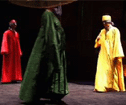
Sonification of Performative Space
Sensuous Geographies is a responsive sound and video environment. It is a space of ritual, a liminal space intended to draw attention both to the intricate inter-weaving pathways of sensation in the body, and to the equally intricate pathways of subtle group behaviour.
The installation comprises a collection of polyphonic electroacoustic sound worlds which are created as the actions of visitors to the installation generate and influence both individual musical layers and the overall texture of the sound environment. Shadowy virtual counterparts of the visitors are projected onto banners, intermittently brought to presence by the motion of those engaging with in the installation. The members of the public who become active participants in this responsive environment immediately become an integral part of the installation itself, as they don richly coloured costumes before entering the active space in order that they can be identified as distinct individuals by the motion tracking which drives the interactive system. The visitors' engagement with and immersion in the sound environment results in a continually evolving world of sound, image, light and colour which visitors can alternately observe from without and experience from within.
Sensuous Geographies is intended primarily to be a space for interaction, for contemplation, even for play. It is in a very real sense a performative space, for the users both generate and become an integral part of the environment as they engage with it. When activated the piece exists simultaneously as a durational 'performance' and an immersive installation environment.
Sensuous Geographies comprises an enclosed space which is hung with banners, some translucent, some opaque. The space is also articulated by the speakers from which the sound emanates. These are placed around the responsive, or performative, space and around the perimeter of the space in which the installation is mounted. The sound is spatialised by the behaviour of the visitors, creating a mobile sound world in which visitors are fully immersed. Projected video imagery which offers a shadowy reflection of the costumes worn by visitors to the space appears and disappears on the banners, which are placed both within and outside of the performative space. The responsive area is defined by a textured floor cloth which gives an implicit geography and shape to the installation environment. [Quicktime video]
Posted by jo at 07:24 AM | Comments (0)
November 29, 2004
Perversely Interactive System
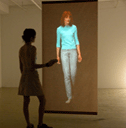
Muted Response Reaps Reward
Perversely Interactive System, by Lynn Hughes and Simon Laroche, puts the spectator into relation with a virtual other whose image (s)he controls through a biofeedback device.
The system is made of a large scale video projection and a wireless "biofeedback handset that monitors galvanic skin resistance (variation in sweat gland activity that measures the level of stress).
The video projection begins with the image of a woman with her back turned. As the participant learns to reduce his or her stress/sweat level, the woman on the screen gradually turns around, and advances towards the participant.
So in this piece, excitation or effort hinders, rather than promotes, successful interaction. If the participant’s tension level rises (often due to the excitement of success) then the woman stops.
Till December 12 at the FILE festival in Sao Paulo. Originally blogged by Regine on near near future.
Posted by jo at 05:46 PM | Comments (0)
LiveForm:Telekinetics

Intertwined Networks
The Waag Society for Old and New Media has in 2004 commissioned Canadian artists Jeff Mann and Michelle Teran to produce and present the second iteration of the LiveForm:Telekinetics Project. LF:TK involves the creation of a series of site-specific installation/performance works connecting hybrid physical/virtual spaces using streaming media and networked kinetic objects. The commission is part of the Connected! project of Waag Society, a two-year programme of performances, lectures, workshops, installations, and emergent events exploring collaborative networked media and live art.
The LiveForm:Telekinetics project is envisioned as a laboratory that examines the intertwining of social networks and social spaces with their technological counterparts. As a work of art, it challenges and expands the notion of performance, the relationship of the artist and audience, production and exhibition, and ideas of locale and presence. The project creates hybrid installation/performative works, augmented with electronic devices and network systems, to create shared spaces and live social situations. Two-way streaming media such as video, sound, and graphics, are used to connect together physical sites via the Internet. Everyday physical objects within the environments become kinetic communications interfaces, animated with embedded sensors and actuators. In LiveForm:Telekinetics, mediating technologies are human-scale, built into architecture, furniture, decorations, utensils, toys, and the bric-a-brac that we surround ourselves with. Read more.
Posted by jo at 10:22 AM | Comments (1)
November 28, 2004
3 Internet2 Experiments

Soundmesh: Design and OSX version: Mara Helmuth; RTmix Collaboration: Brad Garton; Linux version: Ivica Ico Bukvic. Soundmesh plays uncompressed audio data to remote host ips. It handles 44.1KHz au/sun/next or aiff files. It is a RTcmix-3.1.0 based application. You do not need to install cmix as all binaries are included. Because high bandwidth is required, you must be at an Internet2 site to participate.

SoundWIRE: This project is fundamentally concerned with two areas of research: streaming professional-quality audio to remote destinations using next-generation Internet, and developing practical, intuitive methods for assessment of network reliability. Currently, digital audio streaming across the internet is compromised by restricted bandwidth and buffering of audio data to safeguard against network irregularities. The results are signal compression and potentially long delay times.
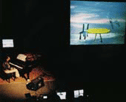
Global Visual Music Project: Goals are to: a) develop software for the creation, mediation, and dissemination of real-time multimedia content, including high resolution two and three dimensional graphics, digital audio and video; b) develop a networking capability for this software, so that multimedia data could be shared between users in many locations; c) organize a high profile event to unveil these resources by staging a networked multiple site public performance with accomplished artists in established artistic and technological venues; d) create a web site to disseminate information about our research; e) freely distribute the software we create; and f) develop and publish a communication protocol for networked distribution of high quality real-time multi-media data.
Posted by jo at 04:05 PM | Comments (0)
arm wrestling: new and old

The Challenge of Haptics
The Wall Street Journal has an interesting article on the technology behind haptics, derived from the Greek word meaning "to touch"...A group of science museums in the US is showing off one form of the technology. The system, dubbed the Internet Arm Wrestling Challenge, uses aluminum arms and hands connected by a series of rods and gears to computer servers linked to the Internet.
Visitors looking for a test of strength sit in front of a touch-screen monitor and ask the computer to look for a potential opponent at another museum. If one is available, his or her picture appears on the screen via streaming Internet video, the two wrestlers grip the metal hands and the computer starts the contest." [via]
We reported on an earlier form of arm wrestling in our post about the two Canadian artists—Doug Back and Norman White—who in 1986 used motorized force-transmitting systems interconnected by a telephone data link and did some telephonic arm wrestling of their own. "You could almost feel the pulse of the other person," White said, "... it was uncannily human-like--the sensation of sinews and muscle--not at all like feeling a machine."
Posted by newradio at 12:23 PM | Comments (0)
Todd Winkler

Motion, Mapping, and Music
Todd Winkler is a composer and multimedia artist on the faculty at Brown University, where he is Director of MacColl Studio for Electronic Music and Chair of the Music Department. His work explores ways in which human actions can affect sound and images produced by computers in dance productions, interactive video installations, and concert pieces for computers and instruments. He is the author of Composing Interactive Music, a book and CD-ROM about the theory and technology of interactive music and performance, published by MIT Press. Winkler has also authored numerous papers.
His recent work uses motion sensing devices to allow dancers creative input into computer music and digital video systems. These dance productions include: Dark Around the Edges, with Walter Ferrero, presented at Carriage House Theater, Providence, Rhode Island; Songs for the Body Electric, with Gerry Girouard, presented in Minneapolis at Intermedia Arts, and at the International Dance and Technology Conference in Tempe, Arizona; Hitch's Bitches, with Cindy Cummings, at the Project Theatre in Dublin, Ireland and the Yale University Multimedia Festival; and Falling Up, with Cindy Cummings, a commission from the Dublin Fringe Festival.
Posted by jo at 11:28 AM | Comments (0)
November 27, 2004
Tactical Media
"The age of distributed media has facilitated political awareness and activism to a mass audience. From clicking to feed the hungry at www.thehungersite.com, to experiencing in real time first hand accounts of the bombing of Belgrade on the (original) Syndicate mailing list, to more recently the Salam Pax blogs from Bagdad, world issues seem very close to home. We've clicked to email politicians and institutions about local arts funding issues and global art sackings, and there were many eager mouse-clicking soldiers in RTMark's Toy Wars campaign, who jointly plummeted the stock price of a corporation that tried to destroy an online art group.
Today we take it for granted that mainstream media has a vested interest, and artists and writers use their skills to create another point of view. These artworks come under the banner of tactical media--'do it yourself' media, where mass distribution networks are used to critique and respond to social issues. They never present a monolithic perspective, but rather are individuals or loose collations defined by their activity that intervene, often subverting or reformatting, the images, texts and icons of mainstream culture."--Melinda Rackham, empyre, Thursday, 3 Jun 2004.
Posted by jo at 04:23 PM | Comments (0)
November 26, 2004
Karakuri
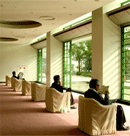
Karakuri: Shadows Working on the World
Presented by Even Eidsten Westvang at VSMM
"Abstract: Within the context of artistic practice as a methodological resource I have built an augmented reality system that allows unencumbered interaction with a structured physics system. The resulting installation artwork is cast as an experimental design laboratory. The 'laboratory' is set wihtin a clearly delineated sub domain of interaction where a rich set of embodied knowledge can inform performativity on the part of users. This allows its further application to a setting of unscripted performance where an anticipatory design process seeks to structure interaction. This paper outlines the components of such an anticipatory design process, theories it can be informed by and within which domains of embodied knowledge it can function. Details of the interdisciplinary and developmental piece Karakuri are presented and analysed. Directions for future research are suggested." [PDF] [Quicktime video]
Posted by jo at 06:02 PM | Comments (0)
The Mobile Audience
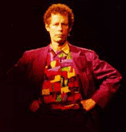
Locative Incarnations
Progress Report 2--The Mobile Audience: Art and New Located Technologies of the Screen by Martin Rieser.
Summary: A critical study examining emergent uses of mobile, wearable and wire free technologies, which move the audience for screen-based work out of the gallery and cinema into public spaces and geographies, with a particular focus on forms of experimental art works using narrative in its new spatialised "locative" incarnations. This continues arguments on reception rehearsed in Rieser, M., Zapp, A. New Screen Media: Cinema/Art/Narrative (BFI, London, 2002), but examines and contextualises more recent and developing work founded on mobile technologies.
This is a book involving primary field research, the principal aims being to develop visual languages and critical discourses around new art and narrative forms using mobile technologies, in particular through examining audience response. Read more.
Posted by jo at 05:15 PM | Comments (0)
November 25, 2004
laptop_orchestra
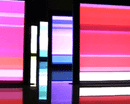
Conducting Synaesthetic Intruments
laptop_orchestra is an interactive synaesthetic instrument designed for performances of audio visual compositions in real time. Fifteen laptops are arranged in rows similar to the formation of an orchestra. Algorithms activate sounds and abstract visual shapes based on the color spectrum; each laptop has its own sound and instructions for the construction of a shape.
Interacting from the orchestra conductor podium by lightly touching metal stems, it is possible to activate or deactivate each laptop, permitting the generation of an endless number of different compositions. Compared to the software of elementary audio and visual compositions, this installation puts the interaction in a defined and public space dimension, drawing a reactive environment in the contour of its physical dimension. Software made with Processing. Download pde file and sound sample.
Limiteazero is an architecture, media design and media art studio based in Milan, Italy.
Limiteazero’s areas of expertise include: network installations design, set design, exhibition design, media in architecture and public space, interaction design, digital identity design, sound design, creative-network-software design.
Limiteazero's experimental activity is concerning the exploration of alternative relations between man, machine and environment, bridging the physical and the digital. It tries to establish an emotional approach using interface systems, instead of a logical/deductive one.
The work around form is mainly focussed on investigating forms and images generated by mathematical processing and through random evolution processes. The "random" sequence is our most used coding expression.
Posted by jo at 12:07 PM | Comments (0)
Suspended Disbelief
When "Majestic" was released by Electronic Arts in 2001, much intrigue was raised by its scope - this was a game that raised the level of interaction several notches by engaging players through unconventional methods such as voicemail, fax, and instant messaging.
Along comes the recent "I Love Bees" phenomenon, a detailed game that was essentially a lead-up to the release of Halo 2 for the Xbox platform. Released online as serial "episodes", the innovation of "I Love Bees" was the component in real space, where gamers used GPS coordinates to arrive at a telephone booth at an appointed time, and, if they were lucky, converse with a voice actor about the developing "I Love Bees" storyline.
Taking things one step further, "Regenesis" is a television show, but one that also allows participants to become more deeply involved. Registering on the show's website will enable you to access online video diaries and a password-protected website. The game's creators also use email dispatches and voice mail to deliver clues.
In film, the state of immersion where you are completely absorbed and temporarily ignore one's internal critical voice is called "suspension of disbelief". Console and online games are also absorbing and can transport players completely into new worlds. When games nibble at the edge of reality, invading traditional spaces of social interaction such as instant messaging and voice mail, the standards for creating a state of suspension of disbelief are raised to incredible proportions. (Posted by Michelle Kasprzak)
Posted by at 01:16 AM | Comments (0)
November 24, 2004
Mulholland Drive
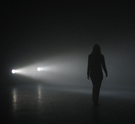
cinema sans image
In Mulholland Drive by D. Scott Hessels, three artists drove Los Angeles' famous Mulholland Drive with five types of sensors—measuring tilt, altitude, direction, speed, and engine sound. The captured data was used computationally to control two robotic lights in a dark room filled with fog. Two beams of light and the processed sound of the engine recreated the topology of the road as a new form of visual experience and sculpture—cinema without image.
Mulholland Drive is a light installation that translates the movement across a topology as two beams of light. Instead of direct human interaction, the work takes the sensed data (tilt, sound, and GPS) of traversing an environment and recreates the drive through angles, light, and sound. A passive interactive experience, the artwork emphasizes the spatial quality of light—it is cinema without image. Like cinema, direct data is captured, then edited, and shaped. However, here the environment directly defines the experience, using the geography computationally. In a sense, “Mulholland Drive” is a new media Earthwork and demonstrates how suddenly the rhythms, patterns, and random chance of the environment can be sensed through new media technologies and used to create new forms of visual experience.
Producing under the name Damaged Californians, Scott Hessels has released experimental art and commercial projects in several different media including film, video, web, music, broadcast, print, and performance for the last decade. His work has shown in international film and new media festivals, on television, and in contemporary art galleries. He recently completed a commission of three interactive films and six online movies for Australia and was honored with a career retrospective at the Melbourne International Film Festival. As a media artist, his installations have shown at CiberArt in Bilbao, the Hammer Museum in Los Angeles, and the Japan Media Arts Festival. Professionally, as Director of Information Technology for Fox Television, he was responsible for the systems, software, communications, and security for two television stations and two cable networks…a career he followed for 25 years. He currently teaches digital video at UCLA in the Design | Media Arts Department and is studying for his graduate degree in that field.
Posted by jo at 01:00 PM | Comments (0)
November 23, 2004
multi-disciplinary research in location aware media
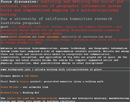
Location-Aware Research
Your participation is desired in an online forum geared toward focusing the theme for an interdisciplinary research residency proposal. The discussion will take place from November 26 through December 5. In the last few years, advances in wireless telecommunication, sensor technology, and Geographic Information System tools have inspired a tide of experimental creative projects. Artists are using these tools and location-aware media to renegotiate how communication, navigation, and big data are played out in space. As the landscape and urban streets become the canvas for computer augmented social and physical interaction, what possibilities emerge for practices outside the arts? How can we mutually inspire and inform diverse practices?
We request your participation in the form of either a question or suggested topic posted to the discussion list. Your inquiry will thus be fielded to an invited list of scientists, researchers and practitioners from diverse disciplines such as cognitive science, anthropology, archaeology, sociology, psychology, literature, science fiction, theatre, history, art history and theory, computer science, and earth sciences. We envision the role of artists in this discussion as minimal, more instigating than expository. You may find you will need to clarify your intended topic. Finding a common language among disciplines may constitute a valuable goal in itself! Your topic or question will alert scientists and researchers to some of the issues or questions that are engaged or encountered by artists working with locative media.
Our goal is to create an open channel for the scientist/researcher quotient of the discussion participants, who may not have considered a creative application of mobile media and mapping in the context of their research. The identification of critical issues, spaces of common interest, and potential blind spots between disciplines is of particular interest. A bibliography will be compiled and made available at the conclusion of this discussion. To participate in the discussion, go to http://34n118w.net/UCHRI
Here you will find directions for subscribing to the discussion list (available by this Thursday), as well as relevant links (available now).
Your input would be a valuable factor in a multi-disciplinary research residency to take place in the next year, pending funding. The research residency itself would be attended by participants chosen through an international open call by the University of California Humanity Research Institute. We greatly look forward to hearing from you. Feel free to contact us with any questions.
Sincerely,
Brett Stalbaum, Lecturer psoe, stalbaum @ ucsd.edu
Coordinator, Interdisciplinary Computing in the Arts Major, UCSD.
Naomi Spellman, Lecturer, spellman @ 4n118w.net
Interdisciplinary Computing in the Arts, UCSD.
Posted by jo at 10:48 AM | Comments (1)
Amsterdam RealTime
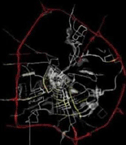
Drawing Routes of Mental Maps
For the exhibition Maps of Amsterdam 1866-2000 at the Amsterdam City Archive, Waag Society and Esther Polak set up the Amsterdam RealTime project. Every inhabitant of Amsterdam has an invisble map of the city in his head. The way he moves about the city and the choices made in this process are determined by this mental map. Amsterdam RealTime attempted to visualize these mental maps through examining the mobile behaviour of the city's users.
During two months (3 Oct to 1 Dec 2002) all of Amsterdam's residents were invited to be equipped with a tracer-unit. This is a portable device developed by Waag Society which is equipped with GPS: Global Positioning System. Using satellite data the tracer calculates its geographical position. The tracers' data are sent in realtime to a central point. By visualizing this data against a black background traces, lines, appear. From these lines a (partial) map of Amsterdam constructs itself. This map does not register streets or blocks of houses, but consists of the sheer movements of real people.
When the different types of users draw their lines, it becomes clear to the viewer just how individual the map of Amsterdam can be. A cyclist will produce completely different favourite routes than someone driving a car. The means of transport, the location of home, work or other activities together with the mental map of the particular person determine the traces he leaves. This way an everchanging, very recent, and very subjective map of Amsterdam will come about. Participants received a print of their personal routes through the city, their diary in traces. [Related]
Posted by jo at 09:58 AM | Comments (0)
The Gambit
![]()
The Narrative Abilities of Flowers
The Gambit is a portable interactive animation sited in the lobby of the Westin-Bonaventure Hotel (John Portman, 1977). The medium of the project is a digital compass attached to a PDA ("personal digital assistant") with a two and a quarter inch by three and a quarter inch color screen and headphones. This apparatus worn by the viewer displays images of spaces normally inaccessible to the viewer's vision from within the Westin's lobby, in other words, as if you're seeing through walls with a kind of periscope.
The "seeing through the walls" has a shape, like Gordon Matta Clark's cuts through buildings. The shape is configured by animated still images and sound. The still images and sound tell a story. The story is of a hotel flower arranger, and of a parallel world where flower arrangements have archival and narrative abilities. The Gambit is a project of Kati Rubinyi.
Posted by jo at 09:45 AM | Comments (0)
global compatibility/mobile conectivity
The possibility of global compatibility and portable, mobile connectivity may not be right around the corner, but it's on its way.
In the Monday, November 15 issue of TheFeature, David James writes that the South Koreans, long leaders in adopting and developing mobile communications, will soon be testing their mobile broadband access system, WiBro (wireless broadband) and that WiBro will be the first country-wide network to serve as a testing ground for what may become the leading international technology for mobile broadband: mobile WiMAX.
"WiMAX is the name now given to that set of technologies sponsored by the WiMAX Forum and based on the Institute of Electrical and Electronics Engineers’ 802.16 family of technology standards for broadband wireless access. IEEE 802.16 is for fixed access, and 802.16e is for mobile access. Both use a form of OFDM transmission, rather than CDMA. The objective of WiMAX and its supporters is to promote global compatibility and inter-operability of broadband wireless access equipment for fixed, portable and mobile connectivity."
There's a lot of testing ahead but Korea plans to begin a commercial service in 2006. For more, see "The Road to Mobile Broadband Runs Through Korea"".
Posted by newradio at 09:14 AM | Comments (0)
November 22, 2004
Affective Turbulence
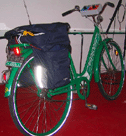
Tactical Urban Maphack
Mirjam Struppek has posted photographs of DEAF04: Affective Turbulence. The Tactical Urban Maphack: Open_Brunch Sensing Location (presentation) included an introduced by Marc Tuters, and the following projects:
FRIDA V [Free Ride Data Aquisition Vehicle]: A W-Lan mapping bicycle by Luka Frelih (SI). Frida V. is a rugged and comfortable bicycle equipped for efficient exploration and mapping of public urban spaces. It carries a small computer, GPS positioning device, 802.11 wireless network transciever and a basic audiovisual recording unit. The consolidated software and hardware assembly enables automated mapping of stumbled wireless networks, easy creation of location-tagged media and opportunistic synchronization with a server resource on the internet.
Cartographic Command Center: Display for locative media by Marc Tuters, Jaanis Garancs. The Mobile Cartographic Command Center (MC3) is the forward command post to engage free and open GIS, educational and commercial geographic institutions, and the tactical media art community in active discourse related to locative media, military conversion, collaborative cartography, and tactical public visualization. The purpose of the project is to actively create and display locative media and free GIS applications (such as, for example, gps3d, GPS satellite monitor/world view, gpsdrive, path tracking, vterrain, earth and SaVi- satellite Visualization).
Biomapping: Mapping the stressfactor in public space by Christian Nold. Bio Mapping is a research project which explores new ways that we as individuals can make use of the information we can gather about our own bodies. Instead of security technologies that are designed to control our behaviour, this project envisages new tools that allows people to selectively share and interpret their own bio data.
Posted by jo at 05:51 PM | Comments (0)
SoundPryer

Truly Mobile Joint Music Listening
Mattias Östergren and his colleagues at the Interactive Institute in Stockholm are designing wireless software for mobile music "socials." But the dance parties they envision take place at 55 miles per hour. SoundPryer is a wireless peer-to-peer system for joint music listening in automobiles. Each driver becomes a mobile radio station, transmitting their digital music stream to other cars within Wi-Fi range.
SoundPryer has similarities to tUNA, a handheld ad-hoc networking radio device demonstrated last year by Media Lab Europe that enables users to tune in to other nearby digital music players, on a school bus for example. And while the PDA-based SoundPryer system can also be used in more stationary face-to-face situations, Östergren purposely kept his eyes on the road when designing the system. First of all, he writes in a scientific paper (PDF), it's a tougher challenge than more stationary systems. The potential duration of interactions between drivers may be extremely short as the cars zip down the highway or, in the event of gridlock, painfully long. The freeway is also a decidedly anonymous zone, perfect for studying how people might react to a new social technology.
From "Wireless Music's New Social Sound," by David Pescovitz, theFeature
Posted by jo at 05:30 PM | Comments (0)
November 20, 2004
Evidence Locker

Retrieval Room
For the Liverpool Art Biennal, American Jill Magid worked with the operators of the city's CCTV surveillance cameras to teach them the techniques of professional filmmakers.
During one month, Magid wore a red trench coat and boots, ensuring she could easily be spotted throughout the city. She called the police on duty with details of where she was and asked them to film her in particular poses and even guide her through the city with her eyes closed - all using the public surveillance cameras. All around Magid, the most innocent passers-by were transformed into potential bag-snatchers, rapists and serial killers by the camera's behaviour.
The final work was made into two installations: Evidence Locker at Tate evokes the space of the CCTV monitoring station, with a soundtrack of the police log being read aloud, and CCTV footage featuring the artist. Evidence Locker at FACT reveals Magid's evolving relationship with the CCTV staff through a daily diary and video projections [until November 28th at the FACT gallery in Liverpool.] From near near future.
Posted by jo at 10:22 AM | Comments (1)
COCKFIGHT ARENA
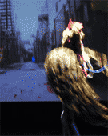
With Wings and Feathered Helmuts
Cockfight Arena (Eddo Stern with Mark Allen, Jessica Hutchins, Karen Lofgren): a one night parade of sweat and adrenaline hopes to reclaim performance art in the age of video games, pitting viewer against viewer in brutal virtual cockfighting theater. Audience volunteers suited up in custom-made wireless game controllers with full sized wings and feathered helmets. Combatants stepped into an arena to control their life size game avatars through vigorous flapping and pecking, competing for blood and birdfeed while rapaciously inflicting onscreen bodily harm in a custom made "joustlike" fighting game. [via]
Eddo Stern was born in Tel Aviv, Israel. His working interests are in structures of narrative and documentary, fantasies of history and technology, cross-cultural representation, and the phenomenological and cultural expanse of computer games. He works discriminately with a wide variety of media—computer games, electronic devices, software, video, sculpture and performance. His work has been shown internationally at new media and film festivals, museums, galleries, and game conventions. In 2000 he started «C-level,» a cooperative artist-run new media lab and art space in LA's Chinatown; currently lives near Los Angeles.
Source: http://www.medienkunstnetz.de/artist/stern/biography/, Florian Zeyfang, Interview with Eddo Stern, Tages Anzeiger, February 2002 and web at http://www.c-level.cc
Posted by jo at 09:53 AM | Comments (0)
November 19, 2004
not yet it's difficult
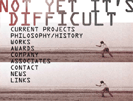
BLOWBACK
not yet it's difficult has a unique presence in Australia's contemporary performing arts culture as a research unit, a producer of industry development programs and a contemporary events maker.
Established in 1995, not yet it's difficult is an ideas-based group of artists who collaborate on the production of public performance events and cross-media projects under the artistic direction of david pledger. not yet it's difficult has produced original theatrical works through its Performance Series, public space projects, play productions, video-installation, new media, television, and, in association with other performance companies, workshop, forum, research and development programs. not yet it's difficult's philosophy is to make work cumulatively and collaboratively. Development practice links research and performance to presentation and analysis. not yet it's difficult's mission is to make critically engaged artworks of high artistic and discursive quality.
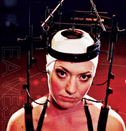
Current projects include: Eavesdrop, 2004, interactive cinema. David Pledger, Artistic Director of not yet it’s difficult and Jeffrey Shaw, world-renowned pioneer of interactive cinema, push the cinematic and the theatrical imaginary in this extraordinary new work. Part game, part real-time film-making, part spectator sport, part magical realism, Eavesdrop opens up the user and the viewer to new ways of looking at old forms, progressive pathways to interactivity and an alternative mode of visual discourse.
Blowback, 2004, theatre: BLOWBACK is an inter-disciplinary theatrical work crossing film, text and dance. Coined by America’s intelligence services, the term blowback describes the situation in which an agent of American foreign policy retracts their support. Using the body and video as double agents, BLOWBACK will be a kind of gestural, agit-prop, horror movie, part science fiction, part documentary, part absurdist metaphor. BLOWBACK will premiere at Memorial Hall, rear St Kilda Army & Navy Club, 88 Acland Street, St.Kilda, Melbourne on 27 November and 4 December 2004 (Previews November 25 and 26).
Posted by jo at 05:10 PM | Comments (0)
Human Pacman

Seamlessly Connecting Between Real + Virtual Worlds
CNN reports on a Human Pacman game, developed by Singapore based researchers, that can be played out in the streets or any real environment. The system was designed by the Mixed Reality Lab at the National University of Singapore. It includes Bluetooth, GPS, head-mounted displays and inertia sensors. Pacman can pick up power pills (in the form of Bluetooth enabled boxes in the environment used in the game) in his attempt to avoid pursuers. Read more at the New Scientist. (via)
Human Pacman has several novel aspects: Firstly, the players immerse in role-playing of the characters, physically moving around in a wide-area setting and performing tasks to reach their goals. Utilizing the computing power of wearable computers and the underlying network support, Human Pacman players experience seamless connections between real and virtual worlds as immersive first-person augmented reality view and full virtual reality view of the fantasy version of the game, Pacworld.
Secondly, Human Pacman also explores novel tangible aspects of human physical movement, senses and perception, both on the player's environment and on the interaction with the digital world. For example to devour the virtual "enemy", the player has to tap on the real physical enemy's shoulder, which is an instinctive action to "catch" the "enemy."
Thirdly, users enjoy unrestricted movement outdoors and indoors while maintaining their social contacts with each other. Players interact both face-to-face with other players when in proximity (physically) or indirectly via the wireless local area network (LAN).
Posted by jo at 11:02 AM | Comments (0)
November 18, 2004
Séa.nce

Perpetual Emotions
Documentation of the Sea.nce performances on board the ISEA2004 ferry is now available.
Séa.nce is a networked performance which is a 'pataphysical' experiment to investigate networked emotions. It is part of The Perpetual Emotions Project. [Related]
Posted by jo at 01:08 PM | Comments (0)
Digital Quilt
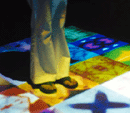
Present and Future Selves
Digital Quilt [silent], by Daniel Peltz, explores possibilities of intimacy within a large group. This installation is made of 414 digitally composed, abstract "self-portraits" projected onto a floor dusted with white chalk. A small camera functions as a sensor, tracking changes in the projected image. When someone steps on the quilt, s/he becomes a part of the image; the camera detects this "change" in the image and sends the information to the program. This data triggers the program to begin a transition from one layer of the quilt to the next.
The portraits are those of students who were asked to create two "self-portraits": one representing how they saw themselves in the present and the other how they saw themselves evolving in the future. Videos of the installation.
Digital Quilt is part of the Intimachine exhibition which presents artworks exploring intimacy, behavior and expectations through machine-mediated interactive experiences (among the work is Haptic Opposition that Max enjoyed so much at Transmediale). At Art Interactive, Cambridge, Mass. from Nov 20, 2004 through Jan 30, 2005.
Originally blogged by Regine at near near future.
Posted by jo at 10:43 AM | Comments (0)
Johannes Gees
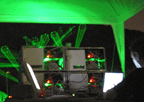
Hello, Hello Again
Recently added to "Showcase"--November 26, 2004 from 10 a.m. to 4:30 p.m.--at the ULTRASOUND festival, Johannes Gees will present and discuss his past and current projects. Gees became known internationally when he presented his interactive text projection, hellomrpresident, during the World Economic Forum in Davos. The piece was also nominated for the Transmediale Award in 2001. It was followed in 2003 by Helloworld, four giant laser text projections connected by internet and mobile phones in Geneva, Rio de Janeiro, Bombay and New York. Communimage--begun in 1999 in an attempt to entertain a visual global dialogue--is an ongoing collaborative art project in which thousands of people have contributed to a growing sea of images.
Gees' work has been shown in galleries and international art shows in Mexico, Brazil, Austria and Switzerland. He lives is Zurich, Switzerland, and is currently working on "Work School Birth Death," a series of text projections in different locations in Switzerland, and a new interactive laser project, "The Fuji San Project" in Japan.
VENUE: The Media Centre, 07 Northumberland St., Huddersfield, HD1 1RL, England; +44 [0]870 990 5007; info @ ultrasound.ws
Posted by jo at 09:33 AM | Comments (0)
November 17, 2004
TEKKEN TORTURE TOURNAMENT
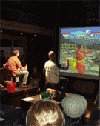
Augmented Empathy
During the Tekke Torture Tournament performance (by Eddo Stern, Mark Allen), 32 willing participants received bracing but non-lethal electrical shocks in correspondence to the injuries sustained by their onscreen avatars. Players wore shocking arm straps wired through a hardware/software hack of the world’s most popular fighting Playstation game TEKKEN 3. LINKS: Official c-level Tekken Tourture Tournament Page; TTT release form
Edo Stern was born in Tel Aviv, Israel. His working interests are in structures of narrative and documentary, fantasies of history and technology, cross-cultural representation, and the phenomenological and cultural expanse of computer games. He works discriminately with a wide variety of media—computer games, electronic devices, software, video, sculpture and performance. His work has been shown internationally at new media and film festivals, museums, galleries, and game conventions. In 2000 he started «C-level,» a cooperative artist-run new media lab and art space in LA's Chinatown; currently lives near Los Angeles.
Source: http://www.medienkunstnetz.de/artist/stern/biography/, Florian Zeyfang, Interview with Eddo Stern, Tages Anzeiger, February 2002 and web at http://www.c-level.cc and http://waco.c-level.cc (via)
Posted by jo at 03:10 PM | Comments (0)
November 16, 2004
Blast Theory in New York

Blazing a Trail in New York City
Downtown Digital Futures: New Technologies, Art, and the Urban Environment presents Blast Theory--Monday, November 22; 7 PM. Schimmel Center for the Arts at Pace University, 3 Spruce Street, New York.
Blast Theory is one of the most adventurous artists' groups working at the intersection of performance, media, and computer gaming. Lead by London-based artists Matt Adams, Ju Row Farr and Nick Tandavanitj, the six member-team uses video, computers, performance, installation, mobile and online technologies to confront a media saturated world in which popular culture rules. Blast Theory will discuss their recent work, an interactive performance/gaming event that fuses the worlds of on-line and off-line players.
In Summer- Fall, 2005, Blast Theory will participate in a two-month residency in New York City, in which they will create a new interactive multi-player game based in Lower Manhattan. The residency will culminate in a site-specific performance — local participants team up with on-line players in an evolving game that blurs the lines between physical and virtual.
[Related (1), (2), (3), (4), (5)]
Downtown Digital Futures is curated by Wayne Ashley for the Lower Manhattan Cultural Council. See the web site for information about 2005 events.
Posted by jo at 10:07 AM | Comments (0)
November 15, 2004
SMS Guerilla Projector

The SMS Guerilla Projector is a high powered, home made projection device that can be used to project SMS messages on to buildings, signs or any other surface. Made by Troika, the London based collective of designers and artists, it consists of a mobile phone, camera lens and slide projector.
Posted by jo at 11:34 AM | Comments (0)
Mobile SCOUT

"Our Automated Quirky Naturalist"
Mobile SCOUT A Mobile Phone and Web Public Art Project by Julian Bleecker, Scott Paterson and Marina Zurkow: are you in a concrete jungle or swamped by tourists? Who's around you, what do you see? A deer, a dump or a daydream? Saintly acts or sinful facts? Mobile SCOUT is a public art project that collects audio narratives of your local surroundings, personal rituals and public sightings. Using your mobile phone, you leave a voice message of your observations with the Mobile SCOUT Ranger, our automated quirky naturalist.
Turn your observations into a brief message about the flora (landscapes), fauna (characters) or behaviors (events) that populate your surroundings. Call the Mobile SCOUT Ranger - 1 (877) 564-3060 - he will guide you through the experience. [via]
When you call you'll:
* pick your mission (flora, fauna or behavior)
* pick two habitat attributes
* leave a recording
Further instructions for operating Mobile SCOUT are available at our online brochure. Mobile SCOUT defines place as being made of social habitats, not geography. Your recordings are organized into an audio/visual field guide according to the kind of space you occupy, be it play, work, nature, culture, public, private, branded or free speech. See the field guide and listen to recordings left by others by visiting the web site.
Mobile SCOUT was commissioned by "The Database Imaginary", an exhibition at the Walter Phillips Gallery at The Banff Center, and curated by Sarah Cook, Steve Dietz and Anthony Kiendl. Mobile SCOUT was produced with support from BeVocal for voice application hosting.
Posted by jo at 11:21 AM | Comments (0)
Capacitor

Capacity for Charged Performances
Capacitor* is a group of interdisciplinary movement artists that accumulate energy from our technologically impacted culture and release it through innovative, multi-sensory performances. One of their pieces, Avatars (2002), takes the characters and themes of computer games and incorporates them into their performances. (Video clips are available of this performance).
From the movement of the human diaphragm to the story of evolution; from the behavior of electricity to genetic manipulation; from the birth of the moon to the cycles of digestion - science and technology form the basis for Capacitor's study of performance. Obsessed with the mechanics of the human body as well as machines that propel the body through space, Capacitor artists have become masters of rigging systems and large-scale props designed to stretch the limits of physical poetry. [via]
*ca·pac·i·tor (kƒ pas‚i tƒr) n. a device for accumulating and holding a charge of electricity.
To cultivate new and relevant performance concepts, Capacitor developed the Capacitor Lab, a think-tank of artists engineers, scientists and philosophers who exchange ideas, share knowledge, and ignite each other's imaginations towards the creation of innovative performance pieces.
The lively dialogues and debates that take place in the Capacitor Lab bring a broader outlook to the creative process and provide a vehicle for critical feedback as new work is developed. By engendering dialogue around contemporary technological and scientific issues, Capacitor aims to find common ground amongst individuals from varied fields of inquiry and, together, shape a new performance aesthetic built on today's innovations.
Capacitor has created works that tackle the creation of the universe (Within Outer Spaces, 2001), the past and future of mankind (futurespecies, 2000), the modern phenomenon of video gaming (Avatars, 2002) and, most recently, a journey through the visible and invisible layers of the Earth (Digging in the Dark, 2004). Capacitor's uncanny and contemplative use of technology won the company an invitation to speak at the Monaco Dance Forum in 2002 and has been covered by Computer Graphics World, Wired.com, SHIFT Magazine, NBC 11's Tech NOW!, CNET Radio, TECH TV, Dance Magazine and The New York Times.
Founded in 1997, Capacitor is grateful for support from San Francisco's Grants for the Arts, California Arts Council, the Zellerbach Family Foundation, Altria Group, Inc., the LEF Foundation, Theatre Bay Area, and the American Composers Forum.
Posted by jo at 10:35 AM | Comments (0)
November 14, 2004
telezone
 more telematic embrace Telematic Connections at the Walker Art Center 2001 presented similar ideas about networked connectivity. WHAT'S CHANGED? We're STILL participatory, we're interconnected - WE'RE WIRELESS.
more telematic embrace Telematic Connections at the Walker Art Center 2001 presented similar ideas about networked connectivity. WHAT'S CHANGED? We're STILL participatory, we're interconnected - WE'RE WIRELESS.
Telematic Connections, like many of the works in it, is a hybrid affair. Part history, part speculation, partly onsite, partly online, it crosses boundaries between art, communications, and popular culture. Its four sections include installation works, past and recent film clips, online projects, and a "telematics timeline." Through these various media, the exhibition presents the ways in which artists use technology—and the Internet—to explore both the utopian desire for an expanded, global consciousness and the dystopian consequences of our collective embrace, willing or not, of computer-mediated human communications. At the same time Telematic Connections places this emergent work within a historical framework.
The eight installations that comprise the "Telereal" component of this exhibition use the Internet and computing to explore this mediated embrace between parties, whether human to human, human to machine, machine to machine, or even human to nature. Here, as well as in the ten online projects in the "Datasphere" component of the exhibition, what the visitor-participant does in the galleries affects (and is affected by) someone or something somewhere else in physical space. "The Virtual Embrace" signals this shift from the viewer as an observer to embracing us as a participant, integral to the work-process of art.
While Telematic Connections presents the possibilities for connections and affiliations, it still acknowledges a persistent question about connective new media. Artist, theorist, and teacher Roy Ascott stated it poignantly already in 1990, "Is there love in the telematic embrace?" Is there content besides technology? Engagement beyond entertainment? A message that is not only the medium?
Telematic Connections is not fundamentally about technology. Nor is it an attempt to define a new genre of art practice. It is about what MIT computer scientist Michael Dertouzos calls "the forces of the cave"—some of the eternal human traits that have never left us, including the desire to connect, even to merge with another—but in today’s world of ubiquitous computing and global networking.
The TeleZone project is a successful example of the integration potential of the Ars Electronica Center. If you look at the list of the persons and institutions who made this project possible - university institutes, technical college courses, the Telekom, the company Wittmann, a project manager who is both an expert in robotics and a student of philosophy, graphic artists, architects, programmers - it almost seems to be a textbook example of the synergy of art, science and research which is demanded ever so often, as well as of the combination of different fields of competencies which are required when faced with the task of dealing with the challenges arising in connection with the new digital technologies.
Apart from the above, however, it is also a prototypical experiment setting for investigating the modern information society based on these technologies. "Software code - more than law - defines the true parameters of freedom in cyberspace. The question of what the architecture of cyberspace should be is not a neutral question. We need to think about it in political terms." This observation by Lawrence Lessing, lawyer and professor at Harvard, puts a crucial issue into words. Which norms and conventions will determine the way we will live together in a world defined by global acceleration and networking?
The most fascinating novel aspect about the Internet, its cultural and economic potential lies in its publicity, the way in which - unlike in any other medium in the past - not only passive consuming is possible but active participation on a broad and general scale. Each participant may act as transmitter or recipient, whatever pleases them more. Owing to this simple technical fact the Internet becomes a lot more than merely a modern information medium - it develops into a strong infrastructure for a community.
Telepresence (in simple words, the possibility of becoming noticeable at a location where one is present only via a network connection).
Posted by michelle at 01:33 PM | Comments (0)
in favor of networked practice

excerpted from Roy Ascott's essay Is There Love inthe Telematic Embrace" (1990), at the Walker Art Center's online show "Telematic Connections":
This question, which seems to be at the heart of many critiques of art involving computers and telecommunications, suggests deep-seated fears of the machine coming to dominate the human will and of a technological formalism erasing human content and values. Apart from all the particulars of personal histories, of dreams, desires, and anxieties that inform the content of art’s rich repertoire, the question, in essence, is asking: Is there love in the telematic embrace?
In the attempt to extricate human content from technological form, the question is made more complicated by our increasing tendency as artists to bring together imaging, sound, and text systems into interactive environments that exploit state-of-the-art hypermedia and that engage the full sensorium, albeit by digital means. Out of this technological complexity, we can sense the emergence of a synthesis of the arts. The question of content must therefore be addressed to what might be called the Gesamtdatenwerk—the integrated data work—and to its capacity to engage the intellect, emotions, and sensibility of the observer. Here, however, more problems arise, since the observer in an interactive telematic system is by definition a participator. In a telematic art, meaning is not created by the artist, distributed through the network, and received by the observer. Meaning is the product of interaction between the observer and the system, the content of which is in a state of flux, of endless change and transformation. In this condition of uncertainty and instability, not simply because of the crisscrossing interactions of users of the network but because content is embodied in data that is itself immaterial, it is purely an electronic difference, until it has been reconstituted at the interface as image, text, or sound. The sensory output may be differentiated further as existing on screen, as articulated structure or material, as architecture, as environment, or in virtual space.
This and other essay by Ascott are compiled in the book by Edward Shaken " Telematic Embrace: Visionaru Theories of Art, Technology and Consciousness".
Posted by michelle at 01:06 PM | Comments (0)
cell phone passed
paroxysmal stage
Miss Mobile has been going for some time. It's from Slovenian director and performer Emil Hrvatin who brings a Reality Telephone Game Show featuring mere talk and invisible performers, of which critic Darinka Nikoli wrote: "Emil Hrvatin's Miss Mobile is one of the most intelligent, boldest and most critically engaged contributions. His interactive performance, based on collaboration of the audience in the theatre and 'virtually' invisible people on the other end of the line, brought to the event via mobile telephones with an incredible amount of manipulation, is the 'bread and games' principle reaching its paroxysmal stage." Miss Mobile has been performed in Gent, New York, Ljubljana, Novi Sad, Paris and Rijeka. Before Boston it will be performed in Rome and Zagreb; after Boston in Los Angeles, Riverside and Santa Ana. Sponsored by Emerson College Institute for Liberal Arts and Interdisciplinary Studies, Emerson College Visual and Media Arts, School of the Museum of Fine Arts Performance Area.
Then Miss Mobile moved to Cal State University Fullerton. A reflection on public/private relations by one Slovene performance artist and 40 audience members and their cell phones. Bring a cell phone if you have one! The artist may ask you to call your friends and allow him to converse.
Emil Hrvatin is a theatre director and performance artist who manages the non-profit organization Maska in Ljubljana, Slovenia. He will perform "Miss Mobile," which is based on a "reflecting of public/private relation." It's a performance in which he asks audience members to call their friends by mobile phones and then he lends them eight phones to do so. The content of the conversations varies; it's basically about politics and people's relationship to it. At the end, audience members vote for the "Miss or Mister of Virtual Characters." Emil is also the artist in residence at the Grand Central from May 1 through May 20, 2003. Miss Mobile will also be featured at Highways Performance Space, 1651 18th St., Santa Monica.
Posted by michelle at 02:05 AM | Comments (0)
November 11, 2004
Kiosk Correspondance
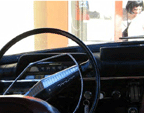
remote-live-networked-interactive-performance
Kiosk Correspondance November 14, 2004, 18:00 - 21:00: Get the facts of gilbertandgrape's whereabouts and mischief in Kiosk Correspondance at the East End Collaborations festival and online. Give us a cassette, a song of romantic significance to play in the Volvo; you can drop it off at the gilbertandgrape office installation at the EEC or email us a suggestion. Kiosk Correspondance is a remote performance with an online connection, and uses phone conversations and live documentation.
Between 2004 and 2008 GilbertandGrape and their lone ranger, a 20 kilo stuffed moose head, will travel the coasts of England and Norway in a Volvo Amazon to search out and collect stories from people with an interest in nostalgia, document vague memories, exchange taped music and watch sunsets at the end of the day.
East End Collaborations 2004
Saturday 13 and Sunday 14 November
an intensive weekend of new work by new artists
Queen Mary, University of London,
Mile End Road, London E1
Venue: The Arts Building, Queen Mary, University of London, Mile End Road, London E1 4NS. (between Mile End and Stepney Green Tubes).
The EEC Platform is an opportunity for emerging practitioners from across London to present new performance and time based works and an invitation to audiences to experience the artists of tomorrow today.
Tickets: £5 (£3 concessions) per day or £8 (£6 concessions) for a 2 day pass.
Bookings: 020 7882 5196
Concessionary tickets are available for wheelchair users and an accompanying person. Please indicate at time of booking any special requirements, wheelchair space or any other mobility assistance. The theatre and other performance and installation spaces do not have hearing induction loops.
Posted by jo at 08:38 PM | Comments (0)
Receiver
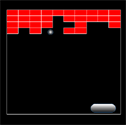
The new issue of Vodafone’s RECEIVER has been released. Content:
* Erkki Huhtamo: Hidden histories of mobile media * Tim Clark: Mobile communications and the wireless internet – the Japanese experience * Amparo Lasen: Affective technologies – emotions and mobile phones * Mike Butcher: Rewind -fast forward-play – mobile Napsterisation * Barry Wellman: The mobile-ized society – communication modes and social networks * Drew Hemment: The telephone exchange * Adam Greenfield: Along the fault lines – designing for deception, dishonesty, and other happy facts of human nature * Cory Doctorow: Eastern Standard Tribe – a story about love, death and cellular telephony * John Chasey: The future of mobile gaming – multiplayer games.
Posted by jo at 10:18 AM | Comments (0)
David Rokeby
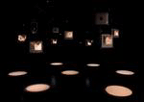
n-Cha(n)t
The title of David Rokeby's award-winning installation n-Cha(n)t is a pun on the verbs enchant, chat, chant, and on the mathematical symbol n, which signifies an unknown value. N-Cha(n)t shows how the power of the spoken word creates community, a sense of togetherness and belonging, and how that very system of sociability goes awry when interrupted by a strange voice. In this particular case the linguistic community consists of a set of cha(n)t(t)ing computers.
The visitor enters the space, where a number (n) of computers and monitors are suspended from the ceiling, intercommunicating (chanting) with each other. Every computer has its own voice, speaking grammatically correct English sentences. In addition, each entity is equipped with a highly focused microphone and voice recognition software. When a visitor speaks into one of the microphones, these words from the outside "distract" that system, stimulating a shift in that entity's 'state of mind'.
As a result, that individual (i.e. that particular computer) falls away from the chant. As it begins communicating this new input to its nearest neighbours, the community chanting loses its coherence, with the chanting veering towards a party-like chaos of voices. In the absence of further disruptions, the intercommunications reinforce the similarities and draw the community back to the chant.
The ears visible on the computer monitors show the state of receptivity of each system. When the system is ready to listen, a listening ear is shown on the screen. If the system hears a sound, it cups its ear to concentrate. When 'thinking', a finger is pressed into the ear. If the system feels over-stimulated, it covers its ear with a hand to indicate its unwillingness to listen. As a system processes speech, the incoming words are displayed in the ear on the monitor.
It is hard not to read the project through a political lens. The computers communicate and interact with each other, and seem to make up a perfectly closed and harmonious communal system. They could go on chanting forever, yet in comes the human visitor/intrudor and disturbs the voice of unison. However, this process is not an abrupt coup détat-style intervention, it is gradual and subtle and almost attributes viral qualities to language. By corollary, there is no instant gratification for the visitor. In this sense n-cha(n)t differs from most interactive pieces where immediate feedback is a marker of responsiveness. Here becoming intimate with the system is not so clear-cut; any community - whether machinic or human - has its defence mechanisms ready to fend off a threat to the consensus or status quo. Concurrently, every system in equilibrium holds the promise of becoming imbalanced by having its defences punctured.
Read an interview about this work at Audiohyperspace.
Posted by jo at 10:06 AM | Comments (0)
Utopia Travel
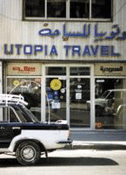
A Journey in Search of (post)modern Utopia
Utopia Travel is a collaborative project by Austrian Artists David Rych and Emanuel Danesch. The basis of the project is the transport of a video collection from Cairo to Vienna, following the transition from the upper part of the African continent over the Middle East towards Europe. An Egyptian taxi equipped with a video monitor served as a mobile unit distributing the contents of the video-archive on the distances between the capitol cities of the respective countries.
The title of the project was taken from the name of a travel agency in Cairo, which befittingly alluded to the ironic circumstance that tourism offers a temporary utopia of exoticism in various directions, whilst discovering no more than just a transmitted fragment of another culture. The archive contains pre-selected video material produced by artists/ film directors originating from and in most cases living in one of the countries on the route.
Every single videotape is labelled with the name of the author and title of the work. The only indication marking region on the label, is a colour code, created by melting the colours of every national flag into one. Since in certain regions (like the states of former Yugoslavia) the colours of neighbouring nations remain quite similar, differences are visible only in very subtle nuances; this makes people guess the precise origin of a work, even if the basic region was quite obvious. The method of presentation provided the opportunity to touch on a variety of issues, from the complexity of individual societies to the construction of political territories. In that sense the project is understood to be a temporary, non-institutional platform focusing on the translation and transmissibility of local cultural codes as different aspects of interrelated history.
The Archive was shown in the taxi as a mobile video installation on a three and a half months long tour through the cities Cairo, Beirut, Istanbul, Sofia, Belgrade, Sarajevo, Zagreb, Ljubljana, Graz and Vienna. The presentations took place to a large extent in public space, while also docking to different institutions for art and culture.
Posted by jo at 10:04 AM | Comments (0)
Bitmirror
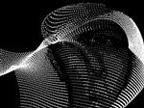
ASCII Shadows
When the visitor enters the Bitmirror space, she sees herself reflected on a big projection screen. A webcam and microphones register movement and sound in the space. A special ImageToASCII generator subsequently renders these data in ASCII form. According to algorithms derived from the laws of nature (gravity, wave motions), the graphic representation on the projection screen is animated into flowing images constructed from letters, digits and punctuation marks. The installation forms a graphic and acoustic shadow world in which abstract particles and signs swarm over the screen.
ASCII is one of the oldest and most elegant stylistic device in computer graphics. The letters stand for American Standard Code for Information Interchange. Computers can only understand numbers, so an ASCII code is the numerical representation of a character such as "v," "V" or "?" or an action of some sort. Seven bits are used for each ASCII character. Bitmirror uses ASCII to graphically represent facial expressions and physical interactions between people. The installation animates visitors' movements in abstract form and reproduces them in a sound synthesis.
Posted by jo at 10:02 AM
November 10, 2004
Sense of the Voice
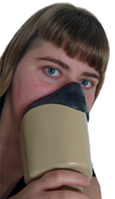
Lecture-Machine
With Lecture-Machine, Michelle Kasprzak takes on the persona of a lecturer. Previous to the performance, Kasprzak wrote a lecture and read it into her computer using a combination of a device called the Stenomask (to isolate the voice) and voice recognition software. The computer interpreted the text that was read to it, making many errors. During the performance this version was read aloud by the computer, while Kasprzak reads the same text into the mask. This re-reading creates a third version of the text, which appears in text format directly into Powerpoint slides. A sonic rhythm emerges between the muffled sound of the voice in the mask and the computer's voice, while audience members can also read a re-interpretation of the text being spoken as it is created on the spot.
From an essay by Lois Brown:
"...Lecture-Machine was very much alive, joyful, even. Lecture-Machine was wry in tone, rhythmic – the dynamic between speech and text and sound almost mesmerizing – certainly entrancing.
Lecture-Machine explores a public and private voice tension – Michelle's training of her device is quite private and her text and presentation public.
Meaning is quite private – she attends to where the machine misunderstands her. Using artefacts of lecture culture, she builds what she calls a "holy trinity" of voice/myself, the Stenomask, and Via Voice software: an impenetrable holy trinity. I heard the computer–voice, the text, and the natural voice all overlapping to create a lulling rhythm – the dynamic in the meanings, mistakes and misinterpretations creating playful "hermeneutic clashes" between the words and contexts." (Posted by Michelle Kasprzak)
Posted by at 11:39 AM | Comments (0)
tejp

Personal Traces on Urban Spaces
tejp "explores various possibilities for overlaying personal traces and information on public spaces through different mediums and behavior patterns. it is our hope that {tejp} will transform spectators into players and encourage playful ways to personalize territory in the public realm. we also hope to connect local communities by providing a space and sounding board for existing social relationships. ['tejp' is swedish for 'tape' and is pronounced {tape}]."
{ tejp | : prototype 1 : audio tags : | glitch }
: principle : audio tags are left at hidden places in public spaces. personal messages that have been previously recorded are whispered to by-passers as they lean towards it. :description of prototype : small boxes covered by designed tejp stickers and fixed on wall and other structures in urban environment. contain a sampler microchip, a small microphone, a speaker membrane, a GP2D15 digital proximity sensor connected to a transistor, and a recording button. hacked gadget. low tech.
Posted by jo at 10:50 AM | Comments (0)
cyberPRINT
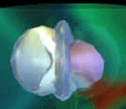
Bodies: Inside Out
cyberPRINT is a virtual reality dance environment...(W)hile a dancer performs on stage, he or she is wearing wireless sensors that monitor key physiological signs (respiratory and muscle activity, cardiac activity and the nervous system). Then, these measurements are captured in real-time during a performance and projected via colorful 3D renderings on a screen for the audience to watch...You can read the main write-up about the cyberPRINT project, which includes a good overview, descriptions of the technologies and images.
Multimedia choreographer and artist Yacov Sharir, the creator of the cyberPRINT project, conducted a workshop about this program at this September's Symposium on Arts & Technology. Here's how this workshop is described:
"The cyberPRINT is a real time Virtual Reality (VR) environment that totally surrounds a dancer during performance. This electronic architectural and musical bio-feedback system is driven by physiologic data drawn from the performer via special sensors attached to her body and transmitted wirelessly to computers which, in turn, generate and project a especially designed and programmed 3D/music world in real time. The resulting "architecture of being" offers multiple expressive choices as its multidimensional character undergoes continuous change. Although the use of the body to electronically drive media events is not new, most of the existing works have paid little or no attention to the potential of interactive 3D and aural virtual environments. Nor have they been so technologically advanced, interdisciplinary involved, or spatially focused as the cyberPRINT. The cyberPRINT has been nationally and internationally performed with success since May 2000." [via]
Posted by jo at 10:37 AM | Comments (0)
November 09, 2004
performing art performing science

Call to Performance
TRANSNET Conference [Transdisciplinary Network for Performance and Technology] asks:
"How can a transdisciplinary perspective communicate new knowledge emerging at the intersection between disciplines?"
"How can this alter approaches to performance?"
Call for Proposals to the conference, June 16-18, 2005 at the School for the Contemporary Arts at Simon Fraser University, Vancouver, Canada.
Posted by michelle at 04:32 PM | Comments (0)
Anxiety, Comfort, and Play in Public Places

Wireless Technology and Social Re-appropriation
Familiar Strangers: Anxiety, Comfort, and Play in Public Places by Eric Paulos and Elizabeth Goodman: The Familiar Stranger is a social phenomenon first addressed by the psychologist Stanley Milgram in his 1972 essay on the subject. Familiar Strangers are individuals that we regularly observe but do not interact with...While today’s mobile communication tools readily connect us to friends and known acquaintances, we lack mobile devices to explore and play with our subtle, yet important, connections to strangers and the unknown – especially the Familiar Strangers whom we regularly see. Will these systems provide a new lens to visualize and navigate our urban spaces? How will these systems provide an interface to strangers and unknown urban settings? What will such devices look like? How will we interact with them? What will they reveal about ourselves and strangers? Will they alter our perception of place? Of the strange and unknown?
Posted by jo at 03:13 PM | Comments (0)
Messa di voce

Can't stop the fun with those walls
At this year's Ars Electronica, I tested the amazing Messa di voce by Golan Levin, Zach Lieberman, Jaap Blonk and Joan La Barbara.
A computer equipped with a video camera tracks the position of visitors’ heads and analyzes the sounds they make. As a reaction to it, various graphic compositions are projected onto a screen. With the help of a tracking system, these visualizations can be shown in a way that makes them seem to be emanating from the mouths of the people themselves. (via inspired by angermann)
More recently, I heard about two other creations that allow people to play with walls:
Greg Roberts' PlayMotion! combines computer vision algorithms and videogame graphics techniques to turn ordinary walls, floors, and ceilings into virtual playgrounds.
Thanks to Bill Read for the tip.

Bloomberg ICE space in Tokyo observes the visitors and continually computes its appearance in accordance with their behaviour. In stand-by mode, the icicle displays columns of numbers. Depending on the current share prices, they expand on the LED display or they shrink and disappear altogether.
But when a visitor approaches the glass wall, infrared sensors detect her/his presence and ask her/him to participate. The columns of numbers begin to flutter and fluctuate; a menu appears and offers various games - electronic volleyball, a wave generator or a digital harp, for example. The icicle can be used to play music synesthetically in that the sounds played are replicated on it in the form of brightly lit, colorful tree branches.
Posted by jo at 01:08 PM | Comments (0)
Location-based mobile phone games
IN-duce published a list for mobile phone games using GPS or cell towers signals, there's also a lists of other location based (or augmented reality) mobile games.
Originally from The Invisible Rabbit, reblogged on near near future.
Posted by jo at 01:03 PM | Comments (0)
M.U.S.H.

Hyperkinetic Possibilities
M.U.S.H. (Multi-User Sensorial Hallucination) is an interactive audiovisual space in which two people in different locations (DEAF04 in Rotterdam and STEIM in Amsterdam) are connected to each other by means of telepresence equipment. The user enters a dark, silent room. S/he can use a navigation stick to activate sound and image. This brings the system into a "hyperkinetic" state: there is a chaotic play of sounds, ghostly images flash, shadows appear and disappear...If the user moves the navigation stick back and forth long enough, rapidly and slowly, the image of the person in the other Mush-Room will gradually appear on the large screen.
The users' movements create the opportunity for a virtual meeting between two strangers. M.U.S.H. is based on synchronicity and creates the conditions for the testing of telepathic possibilities. The navigation stick is a wireless movement sensor that registers the changes in the speed at which the viewer moves it. On the basis of this signal the computer changes the "choreography" and the play of sound and image. To be performed at DEAF04: see details below.
Location Amsterdam: STEIM, Achtergracht 19, Amsterdam
Date: 10 - 21 November, 14:00-16:00 hrs and 18:00-20:00 hrs
Reservations: tickets@v2.nl & (010) 750 28 90
Location Rotterdam: DEAF04, Van Nelle Ontwerpfabriek, Van Nelleweg 1, Rotterdam
Date: 10 - 21 November, 14:00-16.00 hrs and 18:00-20:00 hrs
Reservations: tickets@v2.nl & (010) 750 28 90
Posted by jo at 11:12 AM | Comments (0)
INTERACTIVE FUTURES
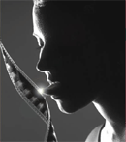
Technology in the Life World
CALL FOR PAPERS, PERFORMANCES, & INSTALLATIONS
INTERACTIVE FUTURES is a forum for showing recent tendencies in new media art as well as a conference for exploring issues related to technology. The theme of this year's event is Technology in the Life World. With digital media becoming more mobile, many artists and theorists are exploring ideas of nomadism and telepresence. Nomadic computing, mobile devices used to augment reality, and more publicly distributed technologies, are being considered by artists and theorists for their ethical and social impact.
Technology in the Life World will be presented in two streams: Digital Nomadism and Technology and Ethics. Artists working in new media are encouraged to submit proposals for installations, performances, and screenings. In their proposals, artists should relate their work to one of the above themes. All art work will be presented at Open Space artist-run centre. Installations should be compact and self-contained. Please see the list of technologies available toward the end of this document before applying.
Victoria Independent Film and Video Festival
Co-sponsored by Open Space Artist-Run Centre
Conference hotel - Laurel Point Inn
Victoria, British Columbia, Canada
February 4-6, 2005.
Scholars and artists working in new media arts, theory, and criticism are encouraged to submit proposals for presentations at the conference. Presentations should be, in part, demonstrative, incorporating digital technologies, interactive or digital video, sound, or network-based elements. In their proposals, presenters should relate their work to one of the above themes. We encourage proposals that push the boundaries of the traditional conference paper. Most presentations will take place at the Laurel Point Inn.
INTERACTIVE FUTURES is part of the Independent Film and Video Festival and applicants are encouraged to check the Festival website for more information on the broader program.
CONFIRMED SPEAKERS / ARTISTS
• Arthur and Marilouise Kroker are internationally known writers and lecturers on the future of technology. Arthur Kroker, Canada Research Chair at the University of Victoria, is the author of numerous book on technology and postmodernism as well as Director of UVic's Pacific Centre for Technology and Culture. Marilouise Kroker is Senior Research Scholar at the University of Victoria as well as co-editor of a trilogy of books on feminism and technology. Together, the Krokers edit the electronic journal, CTheory (www.ctheory.net) and co-curate CTheory Multimedia.
• Char Davies has achieved international recognition for her work in virtual reality. Integrating real-time stereoscopic 3-D computer graphics, 3-D localized sound and user interaction based on breath & balance, the immersive environments Osmose (1995) and Ephémère (1998) are world-renowned for their artistic sensibility, technical innovation, and powerful effect on participants. Davies has dealt with the themes of nature, psyche, and perception in her work for more than 25 years. Davies was a founding director of Softimage, building it into the world's leading developer of 3-D animation software, used for special effects in many Hollywood films including Jurassic Park and The Matrix. She left Softimage at the end of 1997 to found her own art & technology research company, Immersence Inc.
SUBMISSION GUIDELINES
INTERACTIVE FUTURES is interested in artistic and theoretical work that relates to role of new media technologies in the life world.
• Areas of exploration include: nomadism, mobility, augmented reality, telepresence, bio-technology, ecology, and ethics.
• Presentations can be in the form of DVDs, video tapes, games, web-sites, etc.. and should be 45-minutes in length.
• Proposed artwork for exhibition may take the form of installations, performances, or screenings.
• Applications should not exceed 500 words and should indicate whether a presentation or an art piece is being proposed. Please include a 200 max. word bio.
• If your presentation requires specific technologies please describe your needs in detail.
Proposals should be submitted electronically to:
Digital Nomadism
Julie Andreyev
Technology and Ethics
Steve Gibson
All proposals *must* be submitted in text only format either as an attachment or within the body of the email message. Please present examples of your work as a URL to a web-site.
FUNDING
INTERACTIVE FUTURES does not have funding for travel or accommodation. Presenters and artists are expected to apply for travel funding from their home institutions and/or granting bodies. Presenters and artists will be given a pass to all INTERACTIVE FUTURES events and will have access to the “Hospitality Suite” at the Festival hotel (food and drinks). All presenters and artists will be eligible for the conference rate at Festival Hotels (between $40-90 Canadian per night).
DEADLINE FOR ALL PROPOSALS: Friday, December 3, 2004.
Notification of acceptance of proposals will be sent out by December 17, 2004.
EQUIPMENT ACCESS
Laurel Point Inn – Presentations
The following equipment will be made available for all presenters:
• Mac computer with Monitor, keyboard, DVD/CD-ROM drive.
• Data/Video Projector.
• VHS Player.
• Sound system with amp and two speakers.
• Wireless high-speed internet access with DHCP.
Open Space – Art pieces
The following equipment is available for artists at Open Space. Artists should be aware that equipment will have to shared and therefore should not propose to use all of the below devices simultaneously. Art pieces should be easy to set-up and take down. Wherever possible artists should apply their own technology.
• 2 Data/Video Projectors.
• VHS Player.
• DVD Player.
• 3-4 Macintosh computers.
• Sound system with amp, 16-channel mixing board, mics, and four speakers. Eight speakers may be possible by special arrangement.
• Internet connection (shaw.ca).
INTERACTIVE FUTURES Co-Curators:
Steve Gibson sgibson @ finearts.uvic.ca
Julie Andreyev lic @ telus.net
festival @ vifvf.com
Posted by jo at 10:56 AM | Comments (0)
November 08, 2004
Alternative reality game for mobile phones
![bhooo[1].jpg](http://www.turbulence.org/blog/images/bhooo[1].jpg)
Vienen por ellas
"Vienen por ellas (They come for them)" is a Chilean ARG game (alternative reality game), created for Telefonica, that mixes the real world with the game world. Aliens are planning to conquer the Earth. They will capture all the women to fill the planet with "hybrid creatures." Users become part of an anti-alien organisation called Plan-EVA which tries to save the human race by solving quiz, answering questions, finding the clues, etc.
Users play via SMS, voice messages, Web sites, WAP, moblogs, MMS, ringtones, etc. For example, by calling the 321 (called "intercomunicador 321"), the player can listen to his present mission, get clues to solve the riddles, etc. Forums were also created for players to share and comment their experience. So far, the game is a success, with more than 300,000 users (mainly between 12 and 30 years old) registered. (via)
Posted by jo at 12:17 PM | Comments (0)
Run Motherfucker Run

Action Art
Run Motherfucker Run is a trip through nocturnal Rotterdam in installation form. The visitor's running rhythm determines the speed of the treadmill, and this drives up the speed of the pictures. After every film fragment, one can choose between two more short films by turning left or right. In Run Motherfucker Run one is seized by an oppressive feeling. Running through the deserted nocturnal panoramas, one has the feeling one is being chased. While one thinks one has a certain control over one's running speed and the selection of the images, one ultimately realizes that one is being controlled by the machine.
Through an opening in the projection screen, a laser scanner determines the runner's position relative to the screen. When the runner changes position, the speed of the treadmill and the pictures is adapted. For example, if one runs faster, one moves further forward, and this is immediately registered by the computer. A signal is then sent to the treadmill to go faster, and to the pictures to move in faster succession. The sensor can also distinguish whether someone is walking to the left or right within the field of the treadmill. There are two beamers that project a life-sized picture in which the user is incorporated into the stream of images of streets, metro stations, roadways and railway tracks.
Marnix de Nijs demands the audience get involved in his art. Passively standing to the side is not an option in his interactive installations. In particular, he seeks to examine the power relations between humans and machines. De Nijs says, "I'm only offering the steering and the control to the audience to make them more involved, to let them ultimately find out that there is nothing else possible except what the machine dictates, thus actually what I want." The loss of control is something which is experienced as threatening. A feeling of fear is involved in many of De Nijs's installations, increasing the feeling in viewers that they have lost control of the situation.
Credits:
In collaboration with Reinier van Brummelen, Noud Heerkens and Boris Debackere
Co-production: Productiehuis Rotterdam/Rotterdamse Schouwburg, V2_Lab, ZKM
Posted by jo at 12:06 PM | Comments (0)
aura - The stuff around the stuff around you

Sonically Augmented Spaces
The aura project takes this on through the full sonic augmentation of real space. aura rejects visual interfaces (mouse, keyboard, screen) in favour of directional augmented reality using 3-dimensional sound to create a seamless, naturalistic experience. Augmented reality involves the overlaying of digital information onto real space. By moving through the real environment users experience the digital information at the location to which it refers. read more
Posted by michelle at 12:02 PM | Comments (0)
The Dance and Technology Weblog

Dance+Tech Fusion
The Dance and Technology Weblog covers news, trends and developments that relate to the fusion of dance and technology.
"We define the dance world in very broad terms. We cover all types of dance programs -- everything from modern dance performances to Dance Dance Revolution game competitions. And in between we write about interactive dance performances and installations, telepresence (multi-location dance programs), videodance, iPod dance parties, body sensors and motion tracking, virtual dance performances, choreography software, dance instruction tools, dance websites for children, the latest night club developments and much more."
On the Dance and Technology Weblog, you'll also find the Dance Tech Links directory (accessible from the left-side column). Here you can access categorized links to a wide range of dance and technology resources.
If you'd like to submit a story or recommend a website for inclusion in our dance and technology directory, please email Doug Fox. You can send email to doug @ greatdance.com.
When submitting news stories, you can include a picture.
Posted by jo at 11:48 AM | Comments (0)
November 07, 2004
Sensing Space

sponge at V2 DEAF Rotterdam, 9-20 November 2004
Membrane is a set of large translucent screens suspended throughout DEAF04's Van Nelle exhibition hall. Approaching a Membrane, passersby see people on the opposite side re-projected onto the translucent material. A sweep of the hand reshapes, swirls, thickens and thins what one sees through the membrane via dynamics of water, smoke, shockwaves or particles. The system's visual and acoustic responses evolve according to the activity of the visitors with the passage of time. The interplay between the Membrane's calligraphic media and the visitors' moving bodies generates vortices that entangle the Van Nelle factory site's present visitors and past ghosts.
Posted by michelle at 07:06 PM | Comments (0)
DEAF04

participatory locative sound imaging hoedown
Dutch Electronic Art Festival (DEAF) is a biennial international festival for electronic art, presented by V2_, Institute for the Unstable Media, in Rotterdam, The Netherlands.
TRAMJAM V.03- ROTTERDAM RUSHHOUR by Mumbai Streaming Attack is a multi-track- multi-driver mix hub streaming jam session of Rotterdam city vibe, orchestrated in sync with the city's tramlines' routing schedule. Play along November 12 if you're in Rotterdam. Mumbai Streaming Attack is a networked performance study group currently based at SNM/HGKZ in Zurich.
Also at DEAF04 (and simultaneously in New York, Brisbane, Linz, and Singapore) is media artist Zhang Ga's public art project The Peoples' Portrait, where five photo-capturing kiosks, including the location in the Times Square Alliance Information Center at 150 7th Avenue in New York City, are set up globally to capture a diverse range of people in their unique environments. Every few seconds, a central server will retrieve the portraits and display them first in time stamped order, then randomly from the archive. [Related]
Originally posted by Eli Chapman on unmediated
Posted by jo at 06:55 PM | Comments (0)
body architectures
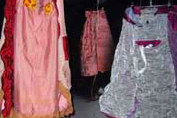
between bodies
is a wearable computing art project by Thecla Schiphorst and Susan Kozel. Their wearable body architectures were recently at the Roundhouse for Vancouver's New Forms Festival. These Sensing Skirts evolved from the Whisper project at Simon Fraser University.
"We use experience modeling to create gestural protocols for physiological data transfer. This design method has been applied to the development of a wearable computing public art installation called “whisper”.
A series of user-experience workshops were designed with the goal of developing an interaction model for the public installation. These workshops modeled intimacy, social navigation and playful exchange, using performance methods to create gestural protocols. Workshop participants generated movement vocabularies by negotiating permission and control of their own physiological data. Gesture was utilized as an expressive indicator of intentionality, extension of body image, permission, control, exchange and play.
We illustrate through video, gestural analysis, and experimental feedback, how the workshops provided an experience model for the interaction, wearable garment design, and body-to-body network protocol used in the public art installation, and how performance methodologies can contribute to the area of interaction design."
Posted by michelle at 03:11 PM | Comments (0)
chojo
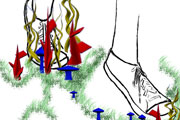
persistent virtual worlds at USCs Integrated Media Systems Center. Using mobile devices students walk through the USC campus leaving behind virtual fragments, represented by small 3d models, as they walk. These objects exist on a virtual world embedded upon a 3d model of the USC campus. Mobile users, using PDAs are able to create new objects, and peek inside the space they are helping to develop. As each object is dropped, it retains a set of unique behaviours, and will interact with other elements in the virtual world. The result will be an emerging, complex series of ecosystems that give life to the virtual space and propel users and viewers alike to engage with the world. more
Posted by michelle at 02:54 PM | Comments (0)
DTPA 2005
Digital Technologies and Performance Arts (DTPA 2005)
Second International Conference for Digital Technologies and Performance Arts (DTPA 2005); SCHOOL OF INTERMEDIA AND PERFORMANCE ARTS, Doncaster College, Doncaster, England; July 5-6, 2005. CALL FOR PROPOSALS; Deadline: January 5, 2005.
This interdisciplinary conference provides a forum for those in the fields of theatre, dance, music and performance (researchers, practitioners, educators, systems developers) for a dynamic and exciting exchange of approaches surrounding the use of new media technologies in live performance. Proposals are invited for papers, performances, presentations, workshops and poster presentations on the following topics:
• Live performance and interactive systems
• Motion capture/motion-sensing technologies
• Performance pedagogy, education and new media
• HCI and live performance
• Web-based performance and virtual performance spaces
• Realtime music control
• Gesture and interactive multimedia
• Interdisciplinarity and new media
• Performance software/hardware development
All proposals should be approximately 200-300 words. Proposals for performances and installations should be submitted with an outline, CD or DVD support, as well as full details of technical and spatial requirements. Workshop proposals should also include information on technical and spatial requirements.
All expressions of interest should be forwarded by January 5, 2005 to:
Dr. Dave Collins
Reader
School of Intermedia and Performance Arts
Doncaster College
High Melton
Doncaster
DN5 7SZ
Email: david.collins @ don.ac.uk
Notification of acceptance will be sent out by the end of March 2005.
Performing arts companies and independent artists may have conference fees waived but will be responsible for travel and accommodation fees.
Presenters may also wish to submit written papers for publication prior to or following the conference to the new International Journal of Digital Media and Performance Arts. http://www.intellectbooks.com/journals/padm.htm
Full registration information will be available shortly on the School for Intermedia and Performance Arts web-site.
david.collins @ don.ac.uk
Posted by jo at 02:16 PM | Comments (0)
flock

flock here
Game and Theater departments in Utrecht (School for the Arts) collaborate on the project Flock, a virtual choreographic work. The project is inspired by computer-games: it's a virtual dance performance completely made on the computer. Flock is an interactive performance for a maximum of 10 players: a multi-player system. All players are connected to one computer (the server).
Flock is inspired on MultiAgent (MA) systems: coordinating intelligent behaviour among a collection of autonomous intelligent "agents", how they can coordinate their knowledge, goals, skills and plans jointly to take actions or to solve problems. Agents in a multi-agent system must share knowledge about problems and solutions.
Graig Reysnolds was the first who made a simulation of a flock: a school of fish or a flock of birds. How can a collection of individual be combined to create a group with a single behavioral momentum? A flock is a group of objects that exhibit the general class of polarised, non-colliding, aggregate motion.
We use motion capture data to animate objects in the environment. These data were obtained in the motion capture studio at the Essex University in England
A special hardware interface will be built which consists of 5 plateaus. The player actively controls the movement of the Flock with her own movements. Together with the other players she travels through 3 different landscapes. The group has to avoid obstacles: by jumping, rolling, crawling etc.
Posted by michelle at 02:06 PM | Comments (0)
November 06, 2004
The Book of Rage and Longing
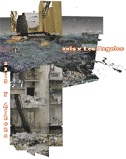
Raging by the Book
In ancient Greek comedy, parabasis named 'a part sung by the chorus, addressed to the audience in the poet's name, and unconnected with the action of the drama.' Calling themselves 'the bodies of rage and longing,' six artists and filmmakers based in the United States - Dimitri Kotsaras, Mr. Flo, Melissa Longenecker, Jennifer Nelson, Michael Wilson, and Natalie Zimmerman - have devised an ongoing, collaborative project to promote parabasis transnationally. With foci in Los Angeles and Athens, The Book of Rage and Longing stages an interrogative return to the putative birthplace of Western democracy. Viewers submit textual or visual rants, connected or unconnected with the daily unfolding dramas of wars worldwide. Unedited, these texts and images are projected on a rooftop facing the Acropolis. An 'interpretive/administrative committee' modifies these contributions, reshaping them into the titular book, segments of which a group of Greek singers then performs. Rea! d in the aftermath of this year's presidential election, these instances of parabasis have begun to seem rather more tragic than comic, as when one self-styled poet opines, 'From those who live like leeches on the people's lives,/ We must take back our land again,/ America.' - Ramsey McGlazer, Rhizome's Net Art News, November 5, 2004
Posted by jo at 10:25 AM | Comments (0)
DIALelbarrio
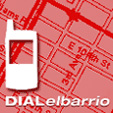
Neighborhood Archives
DIALelbarrio is a project that uses blog technology to build and distribute an audio and image repository of stories about the neighborhood of El Barrio. By allowing users to participate by simply dialing their own mobile device, the project seeks to make contributing information about the neighborhood, its people, places and histories as convenient as making a phone call. DIALelbarrio is part one of a larger wireless project that will make the rich legacy of East Harlem known to all in the Fall of 2004.
Posted by jo at 10:15 AM
Time [Re]Sequenced

user dependent cinema
PLACE--a year long series of exhibitions that explore the role of networked technologies in transcultural experience, organized by MediaNoche-- presents the first exhibition in the series. Time [Re]Sequenced (Networked Cinema) is a project by Cyril Tsiboulski which explores the ways traditional cinematic structure can be affected by new media.
Time [Re]Sequenced is a screen based interactive project in which a four minute scene from Solaris (1972), a Russian film directed by Andrey Tarkovsky, is broken into individual frames by the users accessing the project site. The sequence is then reconstructed and played back using shots initiated by the users. Time [Re]Sequenced depends on and responds to the virtual participation of the audience. A unique network driven algorithm creates a new space and a new language of cinema. Edited in real time, the film sequence can only be reconstructed as a result of audience participation. It depends on the network traffic volume thus creating potentially endless variations. As a contributor to the cinematic structure, but a passive viewer of the result, an audience member is challenged to re-think the role digital technology plays in how we experience our culture.
November 5th - 24th, 2004; Opening reception: FRIDAY, NOVEMBER 5th from 6 - 8p.m.; MediaNoche is located at 161 East 106th Street, New York City.
DIRECTIONS: Take the 6 subway to 103rd Street and walk north along Lexington Avenue to 106th Street. Turn right on 106th Street. MediaNoche is on the north side of the street in the middle of the block.
HOURS: The gallery is open Tuesday through Saturday, from 3PM to 7PM. Appointments can be made by calling 212 828 0401.
http://www.networkedcinema.org
Posted by jo at 10:00 AM | Comments (0)
HARVESTWORKS DIGITAL MEDIA ARTS CENTER PRESENTS
![]()
Diane Ludin + Angie Eng
Harvestworks is pleased to present works by Artist In Residence Diane Ludin and Angie Eng. In MEMORYFLESH 2.0, Diane Ludin has assembled media collages that summarize a variety of stories about the human genome's emergence as a voice of scientific authority and DNA as a rising world power. A fake suturing process is the performative gesture that drives the mixing of Internet media. MENOBILE, by Angie Eng (with sound by David Weinstein), is a new media interactive performance that explores the transition of ones perception from a static life to a nomadic one. Interactive video and sound via Jitter/MAX/SP is used to recreate the poetics of mobility in this multi-projection project.
MONDAY, NOVEMBER 8, 7:00pm; 596 Broadway, Suite 602, New York City, 10012/corner of Broadway & Houston; subway: Broadway/Lafayette (F/V), Bleecker (6), Prince St. (N/R); 212-431-1130 (p), 212-431-7693(f); Suggested Donation $5.00.
Diane Ludin is an artist and writer using the Internet as a material resource since 1996. She recycles existing Internet news media to collage a series of automated records of contemporary communication. Her montages focus on framing the Virtual Body as an almost reality and the core of "embodiment." She has exhibited both her solo and collaborative works in the US and abroad. Commissioned works include Internet projects for The Walker Art Center, Franklin Furnace, Turbulence.org and The Alternative Museum. Collaborative performances and broadcasts with The Electronic Disturbance Theater, FAKESHOP, Las Fantasmas, Prema Murthy, Francesca DiRimini, Ricardo Dominguez, and Agnese Trocchi.
Angie Eng moved to New York City in 1993 to pursue her career in the arts. She co-founded The Poool a live video performance group with Nancy Meli Walker and Benton Bainbridge in 1996-1999. Her work has been performed and exhibited at the Whitney Museum at Philip Morris, The Kitchen, New Museum of Contemporary Art, Renssalaer Polytechnic Institute, Roulette and Experimental Intermedia. This year she has been awarded a Lower Manhattan Cultural Council MCAF grant, a Harvestworks residency and NYSCA funds (New York State Council on the Arts) to develop Memobile that will premiere in the fall 2005.
David Weinstein is composer and multimedia artist whose musical and site-specific installation works have been shown worldwide. His musical works juxtapose sound effects, traditional and non-traditional instruments, synthetic sound, ancient and exotic tunings and noise. As a keyboardist Weinstein has recorded and performed in collaboration with musicians including Shelley Hirsch, Elliott Sharp, John Zorn, Ned Rothenberg, Rhys Chatham and many others. Weinstein's theatrical, installation and multimedia pieces have received a number of grants and awards. He articipated in a long collaboration with the live video performance group, The Poool, and works with the artist Doris Vila on her animated, multi-user, multi-screen, responsive environment installations (cited at Prix Ars Electronica 2002).
Posted by jo at 09:36 AM | Comments (0)
November 04, 2004
Net Guerrilla Ballet
![bi-ir_pr01[1].jpg](http://www.turbulence.org/blog/images/bi-ir_pr01[1].jpg)
wireless illegal remote-controlled net-ballet invasion
Ballettikka Internettikka is an ongoing study of the internet guerrilla performance.
Slovenian ballet dancer Igor Stromajer and composer Brane Zorman will be replaced by toy-robots which will invade the kitchen of the famous [theatre x] and dance an illegal wireless roboballet there. The robots and cameras will be remotely controlled from a mini-van parked in front of the [theatre x].
Live internet broadcasting of the guerrilla ballet performance will start on November 13th 2004 at 20:00 GMT+1 and will last 10 to 15 minutes; the location will be made public on November 13th at 18:00 GMT+1. [Via]
They will enter the kitchen of the famous [theatre x], where bio-food for artists is prepared. The kitchen of the [theatre x] is an excellent example of a modern cooking laboratory for healthy food. It is automatized and meets the highest hygienic standards. The artists will use two remote-controlled toy-robots with two wireless web cameras. Robots and cameras (algorithm of the ballet choreography and MP3 orchestra) will be remotely controlled from a mini-van parked at the north-east side of the [square x] in front of the [theatre x].
This time, Stromajer and Zorman (as ballet dancer and musician) will be replaced by robots, lonely and sad icons, automatized units, which will have no major problem to invade the kitchen of the famous [theatre x] and dance the net-ballet there. Toys transform into guerrilla-ballet dancers.
Stromajer and Zorman will approach the [theatre x] full of respect towards the [theatre x] and its rich history.
Artists will use hi-tech mobile and wireless equipment for the invasion and live broadcasting (portable computers, mini digital camera, MP3 audio systems, mobile WAP telephones etc). A laptop and MiniDV cam, together with Webcam32 (version 6.0) software will be used for broadcasting the video signal (running over Intima Virtual Base FTP server). Another laptop and MP3 player with online interface SHOUTcast (version 1.8.3/win32), will be used for live sound broadcasting (running over Beitthron FTP server). A local GSM mobile phone operator will be used for GPRS mobile internet connection.
# Timetable of the action in [theatre x] - 13. 11. 2004:
11:00 - test and calibratethe equipment, micro-locate at ground zero
19:30 - park mini-van at the north-east side of the [square x] in front of the [theatre x] and secure the location
19:45 - robots enter the kitchen of the [theatre x]
20:00 - start of the live internet broadcasting
20:15 - end of the internet broadcasting
20:20 - robots exit the kitchen of the [theatre x]
20:35 - leave [square x] in front of the [theatre x] and secure the material
Dancing an illegal wireless roboballet in the kitchen of the [theatre x] represents a big conceptual and strategic challenge to the Intima Virtual Base, therefore the preparations have been taken serious, safety measures have been calculated, and the previous experience from the Bolsh.oi Theatre in Moscow has been very welcome.
Note: [theatre x] does not voluntarily co-operate in the project, but was selected based on the conceptual strategy of the project. The management of the [theatre x] is not a co-producer of this project and does not co-operate in the process of its realization.
Project supported by The Ministry of Culture of the Republic of Slovenia
About the authors:
Igor Stromajer is an mobile intimate communicator. He researches tactical emotional states and traumatic low-tech strategies. He has shown his work at more than a hundred exhibitions in forty-two countries and received a number of awards. His works are included in the permanent collections of the Centre Georges Pompidou, Paris; the Museo Nacional Centro de Arte Reina Sofía, Madrid; Moderna galerija Ljubljana, Slovenia; Computerfinearts Gallery, New York.
Brane Zorman is a composer and sound manipulator. Between 1982 and 1986 he was frontman for the Slovene punk group O!KULT. He is a pioneer of Slovene techno scene. Since 1987 he has been composing music for both Slovene and international theatre, dance and multimedia performances and projects. and has made guest appearances throughout Europe. Recently he works with Irena Pivka on a
series of audio-visual installations ZONE.
Ballettikka Internettikka PRESS (2001 - 2003):
...The eleven minutes of live webcasting were watched by more then 400 people. An amazing amount, which even the artist did not expect. Not only did they see Igor Stromajer dancing, but they also saw the conductor of the 'mp3 orchestra' - as Stromajer calls MC Brane - who ironically conducted the mp3's on his laptop like a true Herbert von Karajan. The video of the whole event catches the excitement of the event well. Shot in black and white it leaves one a bit with the feeling of watching an avant-garde performance straight from the early twentieth century, if it weren't for the laptops and mobile phones of course. Both dancer and conductor wear a kind of miners light on their heads. The movements of the light, the speed and accuracy of the operation, the bare abandoned basement and the concentrated moves by Stromajer and MC Brane create a sense of conspiracy that replaces the so called interactivity of on line art without it being missed. In a way it is still there, in the intimacy of the small circle of people who watch this event live, while the management of the Bolsh.oi theatre watches a classical ballet.--# "Claiming the Stage: Ballettikka Internettikka pt 2" by Josephine Bosma, Cream, Amsterdam, Nizozemska (25.04.2002)
Posted by jo at 11:43 AM | Comments (0)
November 02, 2004
Comments Off
Comments Turned Off
Dear Readers,
We have turned our comments feature off temporarily as our office will be closed from November 3rd through 5th. We've been receiving enormous amounts of spam and since we won't be around to intercept it, we thought this was the best solution. Please accept our apologies.
Turbulence
Posted by jo at 05:56 PM | Comments (0)
LOCATION!LOCATION!LOCATION!

GPS Data
Remote Location 1:100,000, by Paula Poole and Brett Stalbaum
Created during August 2004, Box Elder County, Utah, Remote Location 1:100,000 binds together data about landscape and the landscape as data, using GPS influenced tiles, soil samples, paintings and photo documentation. The project is sponsored by the Center for Land Use Interpretation. Paula Poole is adapting landscape painting traditions to new media. She centers on the landscape of the Great Basin desert of North America. Brett Stalbaum is a C5 research theorist and software development artist. He co-founded Electronic Disturbance Theater and collaborates with Paula Poole on land/walking/GPS/ locative/performance/pictorial works.
1:100,000 will be at YLEM Forum: LOCATION!LOCATION!LOCATION!; Three Projects in Locative Media by California Artists on Wednesday, November 10, 7:30 pm; McBean Theater, Exploratorium, 3501 Lyon St., San Francisco, CA. Free, Open to the public and wheelchair accessible. Also included are...
Slipstreamkonza:Autochamber by Christina McPhee with sound collaboration by Henry Warwick
Slipstreamkonza is a sonic topology that remediates carbon absorption and release data from the tallgrass prairie. Autochamber is a sound prototype that interprets data from an active climatologic research site using locative robotic sound within an conceptual practice following the historic HPSCHD by Lejaren Hiller and John Cage. Christina McPhee's new work from the series Strike/Slip/Merz_city will open at Transport Gallery in LA in March-April 2005.
34 north 118 west, by Jeremy Hight, Jeff Knowlton and Naomi Spellman
34 north 118 west uses GPS data and interactive map that triggers live data through movement in downtown Los Angeles. "34 north 118 west" won the grand jury prize at the Los Angeles based Art in Motion Festival, Aim IV, in 2003. Jeremy Hight is a writer fascinated by the weather and 'agitated space'. Naomi Spellman and Jeff Knowlton work in locative media, networked narrative, and were recently Artists in Residence at the Media Centre, Huddersfield, U.K.
Posted by jo at 10:14 AM | Comments (0)
Scan Your Skin

Beneath the Surface
Following in the footsteps of Plug'n'Pray, a new adventure is about to begin. Scan your Skin [SyS] will take the form of a book, web site, and offline activities.
Call for ideas and proposals: Our skin is our vulnerable shell. It protects us and characterizes each one of us as an individual. Besides its physical attributes, our skin conveys differences between people; it takes on ancestral, historical, cultural and political implications. As time flows on, it carves more signs and meanings on our skin. SyS wants to explore this territory from different points of view.
Creative personalities will suggest artistic interpretations of the project message, thus offering their own reading of the human skin. Photography, graphic arts, the written word; a bold, abstract approach or a sober and realistic one - each contribution will be a key component of this multifaceted jigsaw puzzle. The goal is to build a well-structured picture of human skin as a concept/research object. The final work will be published in a book.
Artists, writers, designers and cultural producers: we are calling you! Send us your work! (Format: 1 to max. 8 pages; approx. size: 17x24 cm/6.70x9.45 in) It can be anything from a photo or photo series/sequence, to graphic work, to a story, an article or a poem.
We plan to organize a number of offline happenings and events to support and promote the book, and to link it to an ad-hoc web site: the "Scan your Skin" online project is under construction right now (check it out on www.scan-skin.org, coming soon.)
Posted by jo at 09:25 AM | Comments (0)
November 01, 2004
Augmented Reality

The Eyes Have It
Augmented reality is about taking real things and real places and adding a layer of computer generated information on top of them. In the Thursday, October 28, 2004 Feature article: The Eyes Have It by David Pescovitz, you can read about how tomorrow's mobile phones may project the wireless web right into your eyeballs.
As a near-sighted person sensitive to to the glare of sunlight, this sends shivers through my retinas, but the commercial issue is space -- mobile screens are small and, as Pescovitz says, "there's not much room for expansion inside your pocket", so virtual retinal displays (VRD) are in the developmental stage.
"The small screens and narrow fields of view of mobile devices don't work well with the human vision system," Professor Thomas Furness, director of the Human Interfaces Laboratory, says. "When we first started talking about VRD, the idea was to create a system that requires very little power but can be connected to a PDA or cell phone to deliver a wide field of view with high brightness. For mobile computing applications where you want to overlay digital information on top of what you see, you need the luminance to compete with the outside world."
Augmented reality--computer-generated data superimposed on the real world: You can walk around the city with information about everything you see, passing before your eyes.
Posted by newradio at 11:17 AM | Comments (0)
audio shaker
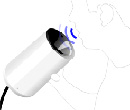
Sound Martinis
The audio shaker --by Tom Jenkins with Mark Hauenstein--explores our perceptual understanding of sound. Anything sung, spoken, clapped, whistled or played near it is trapped inside, where it takes on an imagined yet tangible physicality. Sounds caught in this void are transformed, given weight and permanance, reacting directly to the shaker's movements, subtle or violent. Shaken sounds have to settle down before becoming still and silent, behaving more like fluid than transient energy.
The linear timescale of sound is broken, a conversation is split into words and mixed up in the shaker, and can be poured out separately, tipped out in a simultaneous splash or added to and shaken up further. Put simply, it is a tactile container to capture, shake up and pour out sounds. Creating a rich, intuitive experience that is purposefully open to interpretation and imagination. Quicktime video.
Via near near future
Posted by jo at 11:07 AM | Comments (1)
Software for online Performances
Upstage Walk-Through
The UpStage walk-through is an opportunity to observe people at play in UpStage and to have a guided walk-through of the tools and ideas behind the software with the people who created it.
The next open walk-through will be on Wednesday 3 November at the following times: California, 2am; New York, 5am; UK, 10am; Helsinki, 12 noon; NZ, 11pm. Find your local time at http://www.worldtimeserver.com/
At this session, there will be 2 groups: one for people who are completely new to UpStage, and another for those of you who already know the basics and want to start experimenting. The groups will meet in separate stages - just follow the links from the foyer, http://upstage.org.nz:8081. There are two ways you can participate: you can either come as a "chatter" (audience member) to observe; or you can log in, get dressed (hold an avatar), and experience the full walk-through.
Chatters need only point their browser at http://upstage.org.nz:8081 at the specified time, and follow the links. You will then see and hear (turn your sound on!) what we're doing, and you can participate by typing in the chat window.
To register for the full walk-through, please reply to this email--helena @ creative-catalyst.com--and you will be sent a log-in. We also recommend that you download the manual (online at http://www.upstage.org.nz/download.html) and have a browse before the session.
Posted by newradio at 09:16 AM | Comments (0)
